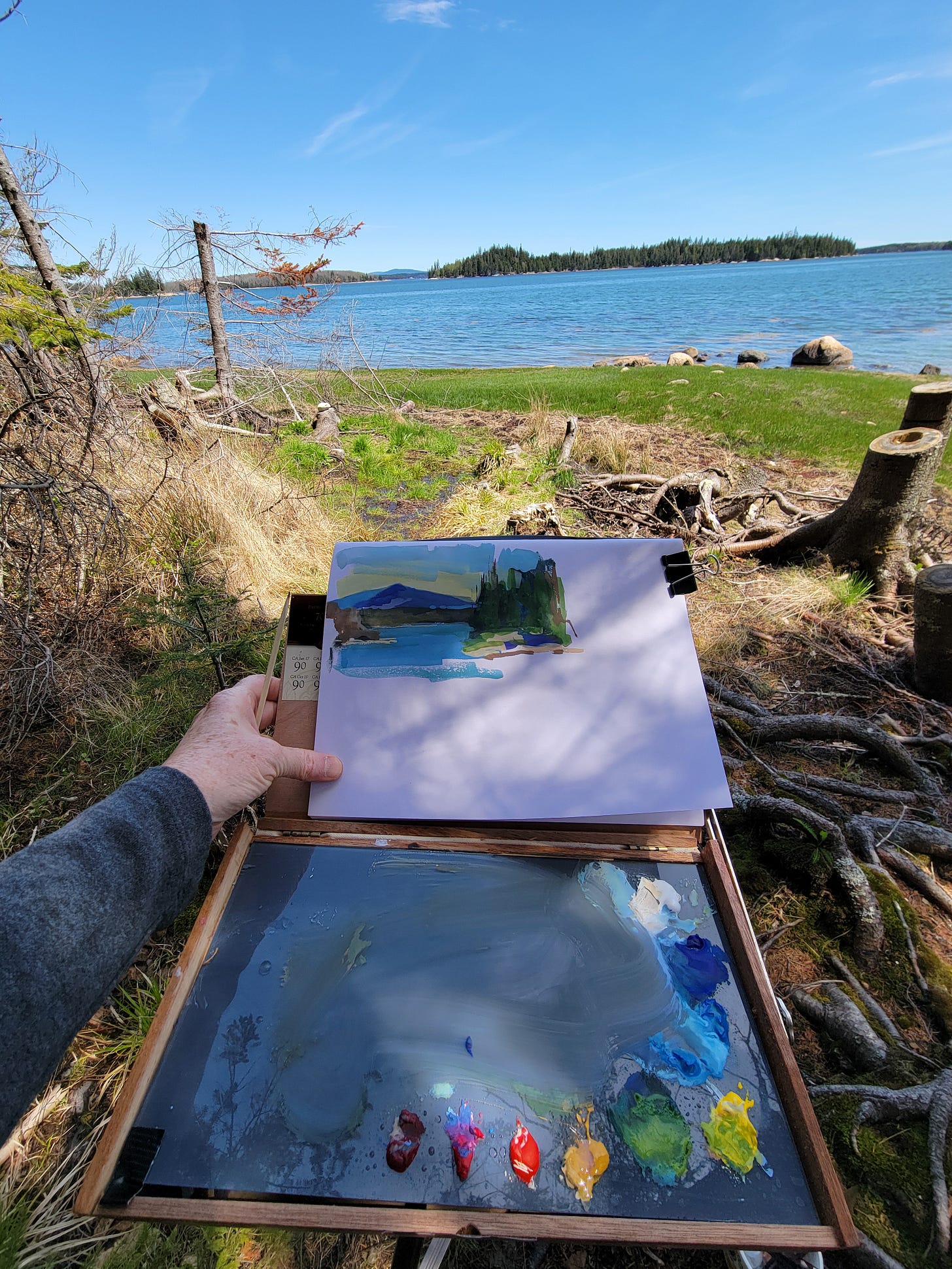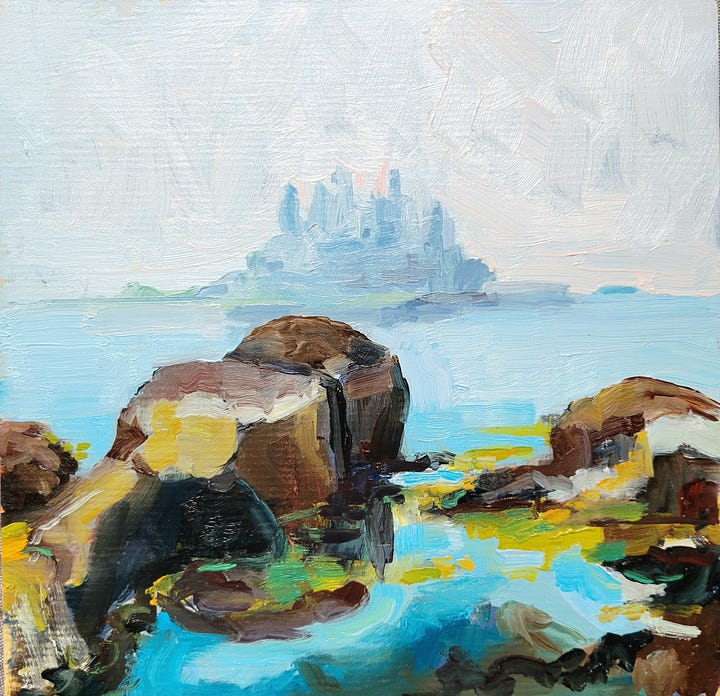Creativity Feeds Creativity—So Does South Philly Tomato Pie
Trying to hold old skills and new ideas at the same time, plus a slice of tomato pie.

I say this a lot here: creativity builds on itself. But learning something new—especially a new technique or way of seeing—can interrupt that flow. You take in new information, and suddenly it feels like none of your skills are working. The work falls apart. You forget the basics. You forget how to draw.
That happened to me last week in Maine.
I was trying to absorb new ideas, but I threw out all the things I already knew how to do. I couldn't figure out how to bring the new and the old together. It was frustrating. But it's also part of the process. The work doesn't always work right away.
When that happens, I try to step back and give myself a kind and useful critique—not harsh, not vague. I ask:
– What didn’t work?
– What did I learn?
– What will I try differently next time?
– How can I bring this new technique into the rest of my practice?
It takes being present. You need to hold onto what you know while making room for new ideas. That’s hard because the creative state often feels like losing yourself—what the ancient Greeks called chaos, the timeless zone where everything flows. As I had written previously:
In our world obsessed with measurable, chronological time (Chronos time), there's another dimension that often goes unnoticed - Kairos, the Greek concept of an opportune or lucky moment. Kairos is personified as the minor god, Caerus, symbolizing luck and opportunity. I find solace in the idea of Kairos - a timeless realm outside the rigid boundaries of measured time. It's a feeling I experience when I paint, a moment of lived experience that leaves me craving more.
This is part of why I don’t think AI can replace human creativity. Artists create because the process itself is rewarding. That brain-on-fire feeling keeps you going. One idea leads to the next, and the next, and the next.
Scavenger-hunting joy wrote recently on Substack about that energy—how once she starts creating, she just wants to keep going. I’ve enjoyed watching her push through the frustration phase. It reminds me of how far I’ve come. I always love seeing people grow, and I admire anyone who stays curious.
Back to Maine: I didn’t do much painting. It was a working trip—house repairs, chores, and cold rainy weather. It’s an old place and always needs attention, especially after winter. Plus, it was “sister week.” My sister Gillian and I have made it a tradition to spend time there together each spring. She loves fossil hunting and rocks, so while she searches, I paint.

Despite the weather and the to-do list, I did manage two oil paintings. I left them in Maine to dry. One might stay there for a future gallery show. I’ve included a short video above with my self-critique of the work.


South Philly Tomato Pie
And yes, I’m back in Philly with a recipe. You’re getting the Philly tomato pie this week. It’s not pizza. It’s better.
This is that thick, chewy, room-temp tomato pie you find in old-school Italian bakeries. It’s a tomato-forward slice that holds its own without a ton of cheese. It's great any time of day—even cold for breakfast.
Crust: You can use any thick-crust pizza dough, but I use focaccia.
Tomato Sauce:
2 tablespoons extra-virgin olive oil
6 garlic cloves, minced
1 shallot, minced
1 teaspoon anchovy paste
1 tablespoon dried oregano or fresh
Fresh chopped basil to taste
1 teaspoon red pepper flakes
1 (28-ounce) can crushed tomatoes
1 tablespoon sugar
Kosher salt, to taste
1 tablespoon balsamic vinegar
1 tablespoon grated Pecorino Romano (optional)
Instructions:
Sauté garlic and shallot in olive oil over medium heat.
Once softened, add anchovy paste, sugar, red pepper flakes, and a pinch of salt.
Stir in the tomatoes.
Simmer on low heat, stirring occasionally, until reduced by nearly two-thirds. It should be thick—more like a paste than a sauce.
Add oregano, basil, and balsamic vinegar. Stir to combine.
Turn off the heat and let the sauce cool to room temperature before using.
If Using Pizza Dough:
Preheat oven to 425°F.
Stretch dough into a rectangle on a well-oiled sheet pan—don’t roll it flat; you want the bubbles.
Generously oil the top of the dough.
Spread cooled tomato sauce evenly over the top.
Sprinkle with a small amount of cheese (optional).
Bake for 20–30 minutes until the internal temp hits 210°F.
Slide off the sheet pan and cool on a wire rack.
If Using Focaccia Dough:
Preheat oven to 475°F.
Follow your focaccia recipe—don’t use parchment paper at this temp.
Bake the dough for 10 minutes.
Remove from oven and gently spread the room temperature sauce on top.
Return to top rack of oven and bake for another 10–12 minutes, until the internal temp is 210°F.
Remove from pan and cool on a wire rack.
Related Substack Posts if you want to continue this exploration:
🎨 Still a few spots left!
Join me for my Landscape Painting Workshop on May 29 & 30 at Main Line Art Center.
Morning and afternoon sessions available—come for one or both.
All levels welcome, oil and watercolor painters.
If you enjoyed this post and want to support my work, feel free to leave a tip! Your support helps me continue sharing my art process, insights, and recipes, without the commitment of subscribing.
Finding Creative Ground is a reader-supported publication. To receive new posts and support my work, consider becoming a free or paid subscriber.







Thanks for taking us along on your journey as you experiment and learn.